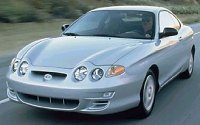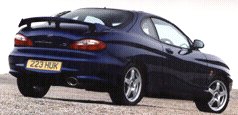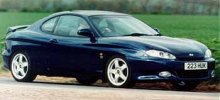 Japanese
car makers used to monopoly the affordable coupe market. In its peak,
there
were countless names engaging the market, such as CRX, Prelude, MR2,
Celica,
NX, 200SX, MX3 ... now these cars are either grown up in both size and
price or passed away, leaving Korean car makers the best opportunity.
Not
many cars left in this price-sensitive segment: Hyundai Coupe and the
little
Ford Puma are the strongest among them. Japanese
car makers used to monopoly the affordable coupe market. In its peak,
there
were countless names engaging the market, such as CRX, Prelude, MR2,
Celica,
NX, 200SX, MX3 ... now these cars are either grown up in both size and
price or passed away, leaving Korean car makers the best opportunity.
Not
many cars left in this price-sensitive segment: Hyundai Coupe and the
little
Ford Puma are the strongest among them.
The Hyundai Coupe, or Tiburon, has been revised recently. Basically, the heart and bones are still unchanged from the one launched in 1996, but the the exterior and cabin are facelifted a lot and many significant changes were made to enhance handling. If you don't remember the old car, let me spend a little bit time to recall your memory. The original Tiburon was loosely based on Elantra / Lantra sedan, with the same MacPherson strut up front and dual-link at the rear. Since 1999, the sedan also share the coupe's 1975 c.c. 4-cylinder engine. This implies that the engine wasn't specially tuned for coupe use, although it has twin cam and 16 valves. Peak power 137 hp is just so-so for a coupe, and the long stroke profile prevent it from revving as eagerly as Ford Puma's 1.7 Zetec. At high speed, the engine became loud and harsh to ears. Torque, however, is benefited by the long stroke. Sadly, the iron-block engine is carried over to the new car without much alteration. Although work has done to iinsulate the noise from the cockpit, the result is still unsatisfactory. Noisy isn't a sin for a coupe, but harsh noise is. In contrast, suspension has been tuned with the help of Porsche. As usual, Korean car makers reveal little or virtually no information about what the Western consultants have done, so we can only guess from the outcome. Obviously, the new Coupe is even better to drive than the old one. The power steering has been recalibrated to provide a more linear and natural feel, so communication between front contact patches and driver has been greatly improved. The chassis is very balanced and neutral so that throttle steer is easily accessible. Attack a hairpin, ease the throttle and feels the lift-off oversteer intervene smoothly. Rear wheels swing out, applies opposite lock to the steering wheel, power again, then the car tightens its line neatly and exit the corner. It's so simple to obtain driving fun. Handling is raised to another level. Praise should be given to Porsche because handling becomes so good yet ride comfort remains satisfying. Hyundai itself spent more efforts to the styling and packaging. The original Tiburon was inspired by the HCD III concept car, the new car looks even more so. The restyled bumpers front and rear incorporates aggressive ventilation holes and lamps that are shaped to match the overall styling theme. Front and rear lights might look overstyled but they are fresh to eyes. Some people said it copied the previous (6th) generation Toyota Celica, especially is the four circular headlamps. So what ? the previous Tiburon already looked 90% alike the 5th generation Celica ! Interior design (also totally new) may arise less controversial, but it is even more futuristic. Upper half of the curvy dash is coloured in metallic grey with a techno feel. Two circular ventilation holes have aluminium-looking crowns surrounded, very TT. Even more TT-styled is the shifter surrounding crown - not only looks like machined aluminium, but also with screws to mirror the oil-filler cap of TT. Admittedly, plastic material is not in Volkswagen level, but I think it is not too important. If the dash is lack of styling, it needs quality material as compensation. If it's as stylish as this one, who cares about the plastic ? After all, it's not bad in Tiburon. As
seen, Tiburon is strong at design and handling, both are very important
to coupe buyers. Performance is not too impressive though, but who else
is significantly faster ? at this price range I'm afraid no. In the
end,
its greatest rival is still the European Ford Puma, with better engine,
equally impressive handling and slightly cheaper, but Hyundai is
bigger,
roomier (rear seats are not just dog-seats) and have a stylish
interior,
so both cars are the winners. If Hyundai had improved the engine, it
would
have been .... |
| The above report was last updated on 26 Feb 2000. All Rights Reserved. |
 The
first thing to notice is the increase of punch : from 137 horses to
154,
from 133 pound-feet to 140. The displacement remains unchanged at
1975c.c.,
so the performance gain comes from a faster intake camshaft and a lower
back pressure exhaust system. Coupe (Tiburon) used to be the best
Hyundai,
now wearing the "F2 Evolution" badge it is even better.
The
first thing to notice is the increase of punch : from 137 horses to
154,
from 133 pound-feet to 140. The displacement remains unchanged at
1975c.c.,
so the performance gain comes from a faster intake camshaft and a lower
back pressure exhaust system. Coupe (Tiburon) used to be the best
Hyundai,
now wearing the "F2 Evolution" badge it is even better.
 The new
name is donated by
the F2 rally car, while the changes in exterior are the work of Peter
Steven,
the stylist of McLaren F1, Lotus Elan etc. With sounded engineering
background,
Mr. Steven added an aggressive air dam plus an eye-catching rear
spoiler,
these reduced the aerodynamic lift to zero. Accompany with the refined
drivetrain which generate no more noise than ever and a cruise control,
it seems that the F2 favours Autobahn more than rally route. But then
wind
noise and road noise may let you down.
The new
name is donated by
the F2 rally car, while the changes in exterior are the work of Peter
Steven,
the stylist of McLaren F1, Lotus Elan etc. With sounded engineering
background,
Mr. Steven added an aggressive air dam plus an eye-catching rear
spoiler,
these reduced the aerodynamic lift to zero. Accompany with the refined
drivetrain which generate no more noise than ever and a cruise control,
it seems that the F2 favours Autobahn more than rally route. But then
wind
noise and road noise may let you down.